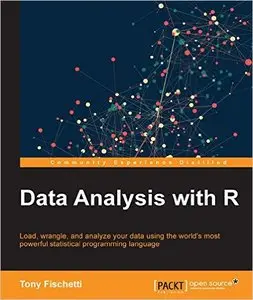Data Analysis with R by Tony Fischetti
English | Jan. 6, 2016 | ISBN: 1785288148 | 446 Pages | AZW3/EPUB/PDF (conv) | 21.21 MB
English | Jan. 6, 2016 | ISBN: 1785288148 | 446 Pages | AZW3/EPUB/PDF (conv) | 21.21 MB
Frequently the tool of choice for academics, R has spread deep into the private sector and can be found in the production pipelines at some of the most advanced and successful enterprises. The power and domain-specificity of R allows the user to express complex analytics easily, quickly, and succinctly. With over 7,000 user contributed packages, it's easy to find support for the latest and greatest algorithms and techniques.
Key Features
Load, manipulate and analyze data from different sources
Gain a deeper understanding of fundamentals of applied statistics
A practical guide to performing data analysis in practice
Book Description
Starting with the basics of R and statistical reasoning, Data Analysis with R dives into advanced predictive analytics, showing how to apply those techniques to real-world data though with real-world examples.
Packed with engaging problems and exercises, this book begins with a review of R and its syntax. From there, get to grips with the fundamentals of applied statistics and build on this knowledge to perform sophisticated and powerful analytics. Solve the difficulties relating to performing data analysis in practice and find solutions to working with “messy data”, large data, communicating results, and facilitating reproducibility.
This book is engineered to be an invaluable resource through many stages of anyone's career as a data analyst.
What you will learn
Navigate the R environment
Describe and visualize the behavior of data and relationships between data
Gain a thorough understanding of statistical reasoning and sampling
Employ hypothesis tests to draw inferences from your data
Learn Bayesian methods for estimating parameters
Perform regression to predict continuous variables
Apply powerful classification methods to predict categorical data
Handle missing data gracefully using multiple imputation
Identify and manage problematic data points
Employ parallelization and Rcpp to scale your analyses to larger data
Put best practices into effect to make your job easier and facilitate reproducibility
About the Author
Tony Fischetti is a data scientist at College Factual, where he gets to use R everyday to build personalized rankings and recommender systems. He graduated in cognitive science from Rensselaer Polytechnic Institute, and his thesis was strongly focused on using statistics to study visual short-term memory.
Tony enjoys writing and and contributing to open source software, blogging at http://www.onthelambda.com, writing about himself in third person, and sharing his knowledge using simple, approachable language and engaging examples.
The more traditionally exciting of his daily activities include listening to records, playing the guitar and bass (poorly), weight training, and helping others.
Table of Contents
RefresheR
The Shape of Data
Describing Relationships
Probability
Using Data to Reason About the World
Testing Hypotheses
Bayesian Methods
Predicting Continuous Variables
Predicting Categorical Variables
Sources of Data
Dealing with Messy Data
Dealing with Large Data
Reproducibility and Best Practices



